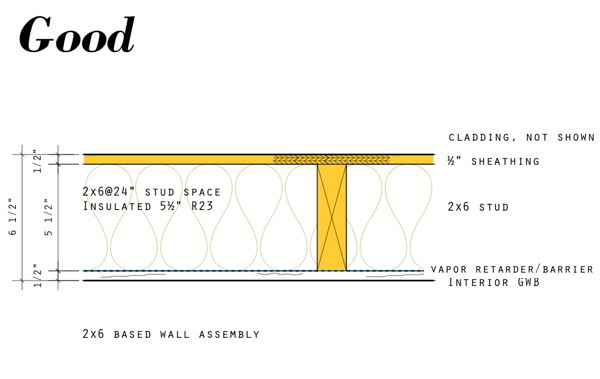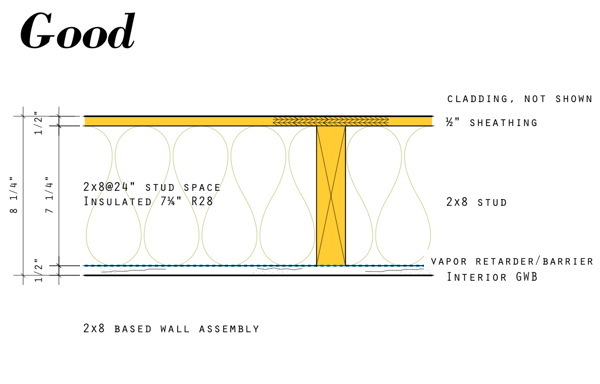USA New Wall - The Good Wall
The first configuration of the USA New Wall we are going to look at is the Good wall. The Good wall is all about what is the greatest gain for the least effort. How can we make the wall we build every day perform better without loosing any sleep or worry about how to build it. We don't want to know about sprays or blows - we want to work the way we know how to, but we want to build a Good wall.
The Good wall is all about increasing the insulation value in the wall cavity. So first of all we use 2x6 studs and the configuration of the framing is expanded to 24"oc. Mineral wool batts rated at R23 are used in place of the more common fiberglass at R13 or R19. Mineral wool batts are unfaced, so that means we need to introduce a vapor retarder or vapor barrier membrane. Which you use will depend on which climate zone you are located in, and whether or not your home has air conditioning.

The second Good wall is the 2x8 based version which uses R28 mineral wool batts to raise up the performance of the wall even higher.

Batt insulation generally has a bad reputation among green building fans because fiberglass batts are typically installed so poorly. Batts are floppy and soft, hard to cut and trim. Installers typically leave gaps and holes and it makes it ineffective. Mineral wool batts overcome all of these problems. They are dense, and easy to handle, fill all voids, and are easy to trim around obstacles. Installations are easier, better, and all told less effort than fiberglass. Mineral wool has dimension - it is not like a blanket, but more like a block. It can be measure, and cut, in a very carpentry like fashion. As such small homebuilders will readily take to working with it.
The second reason fiberglass batts are reviled is because the attached vapor retarders they come with never create an air-tight envelope. Wires and electrical switches create openings into the wall cavity and allow moist interior air to penetrate. Historically houses were not particularly tight from the inside or outside, so this did not matter, much, but the advent of house-wraps changed all this. Previously houses were hung with tar coated paper prior to being sided. This tar paper kept water out and breathed water vapor, but it was not airtight. This meant that any water that got into the wall cavity could dry, including moist air leaking into the wall from the interior. But suddenly housewrap made the outside of the wall airtight. Housewrap still let vapor pass through, but suddenly the outside of the wall was much tighter than the inside of the wall. Vulnerability to mold was the result, and this is something that still plagues houses of more recent vintage that aspired to be more air tight.
A new and popular product now in the mix is Huber's Zip wall sheathing, which is like a wall sheathing panel with a housewrap built in. All the joints are taped with this product and it makes a very tight air barrier at the outside of the wall. This is great, but remember that it is sheathing + housewrap in one.
To complicate matters summer cooling of homes has become much more common than it ever was in the past. Where in the past the inside and outside of the house could be assumed to be nearly the same temperature and relative humidity during the summer. Now suddenly the inside was cooler, and warm humid summer air would be coming in contact with the interior surfaces and suffering condensation. This could happen even in climates that experienced a significant winter. Suddenly the wall needed to work both ways, like a northern heating climate house, and like a souther cooling climate house. At the same time.
We need a range of responses to this in order to avoid creating condensation problems in exterior walls. One response to this has been to make a wall that, so called, dried to both sides - a wall with no vapor retarder or barrier. I think you have to accept that in reality that a wall that drys from both sides is also a wall that wets from both sides. This kind of wall needs to be planned very carefully to have both the interior and exterior pass vapor at a similar rate. Often sheathing and drywall are the two barriers on each side, and often they do not have the same rate of transpiration. If they don't then during one season or the other the wall will load with moisture faster than it can dry.
Instead I think we should take an active role in determining how the wall will perform. If you're located in Zone5, or the northern margins of Zone4 as I am, you should use a vapor retarder that adapts to humidity such as Certainteed's Membrane. This vapor retarder membrane has a low permeability level in dry conditions, but if it becomes wet with condensation it will open up to allow the moisture to dry to the other side. If you are in zones 6 or 7 and will air-condition your home you should also consider this adaptable vapor retarder. If you are in zone 6 or 7 without cooling, then a full on vapor barrier is less expensive and more appropriate.
If you are building a house without cooling, I would lean towards a building paper solution instead of housewrap. This will allow the maximum amount of drying of the wall during the winter heating season. But it also means that your vapor retarder/barrier must become your primary means of making the house air-tight. This is a near impossible task if your wall is punctured with electrical boxes and switches - count on your outlets moving to the floor, and your switches only on internal walls.
If you are building a house with cooling you may want to use housewrap to keep more of the summer air out of your wall cavity during the cooling season. However you still should strive make a very tight interior envelope with your vapor retarder. You don't want to allow interior moist air into the wall during winter because it can condense to water and become a source of mold. The typical weak point for this is the rim joist at the floor levels. This is typically not insulated as well, and often is lacking a vapor retarder at all.
All of these issues are more risky with the Good wall, because it is so similar to the lousy status quo walls. But that's exactly why this wall is an easy first step. If you want to overcome some of these problems and raise the performance even further, then you need the Better wall, coming up next.




No comments:
Post a Comment